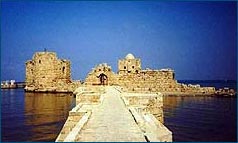| Random image |
 |
.jpg)
The 14th of February Memory
|
 |
|
 |
 |
SIDON
 Sidon, the
largest city in South Lebanon, is one of the famous names in
ancient history, and was inhabited as early as Neolithic
times (6,000-4,000 B.C.) Sidon, the
largest city in South Lebanon, is one of the famous names in
ancient history, and was inhabited as early as Neolithic
times (6,000-4,000 B.C.)
The city was built on a peninsula facing an island,
sheltering its fleet from storms and served as a refuge
during military incursions from the interior. Many of its
remains and ancient objects can now be seen in foreign
museums.
Like all other Phoenician city states, Sidon suffered from a
succession of conquerors.
Sidon's Phoenician period began in the 12th-10th Century BC
and reached its height during the Persian Empire (550-330
BC). The city provided Persia, a great land power, with the
ships seamen to fight the Egyptians and Greeks, a role that
gave it a highly favored position. The Persians maintained a
royal park in Sidon.
Glass manufacture, Sidon's most important enterprise in the
Phoenician era, was conducted on a vast scale and the
production of purple dye was almost as important. The small
shell of the Murex trunculus was broken in order to extract
the pigment that was so rare it became the mark of royalty.
Under the successors of Alexander, Sidon, the "Holy City" of
Phoenicia, enjoyed relative freedom and organized games and
competition in which the greatest athletes of the region
participated.
When Sidon, like other cities of Phoenicia, fell under Roman
domination, it continued to mint its own silver coins. The
Romans also built a theater and other major monuments in the
city. During the Byzantine period when the great earthquake
of 551 AD destroyed most of the cities Phoenicia, Beirut's
School of Law took refuge in Sidon. The town continued
quietly for the next Century, until it was conquered by the
Moslems in 636.
Today, it is a growing city with a modern seaport, and the
south's commercial and financial center, with the following
main attractions:
Crusader Castle
One of the most outstanding remains are the ruins of the
Crusader sea castle built in the 13th century to protect the
harbor and the Castle of Saint-Louis, known as the land
castle. Today, the Castle consists primarily of two towers
connected by a wall. In the outer walls Roman columns were
used as horizontal reinforcements, a feature often seen in
fortifications built on or near former Roman sites. The west
tower is the best preserved out of the two.
Old prints of the fortress show it to be one of great
beauty, but little remains of the embellishments that once
decorated its ramparts.
Resthouse
A government Resthouse on the water front next to the castle
offers good food and refreshment. Situated in a restored
medieval building, the Resthouse is set in a landscape
seaside terrace. The interior has vaulted ceilings and
medieval decor. There is also a fine patio with a fountain.
Khan El Franj
Large khanis (inns/warehouses) were constructed to serve the
principal port for Damascus. Khan El Franj (Inn of the
Foreigners) was built by Emir Fakhreddine to receive French
traders and travelers from the 17th to 19th centuries.
Grand Mosque
Not far and almost on the coast is the Grand Mosque which
was built on the foundations of the Church of St. John of
the Hospitalers, originally built by the Crusaders in the
13th century.
The Souks
Not far from the Sea Castle is the picturesque vaulted souk
of Sidon, where workmen still work their trades. On the edge
of the souk is a traditional coffee house where male
clientele meet to smoke the narguileh (water pipe) and drink
Turkish coffee. Fishermen sell their latest catch at the
market near the port, not far from the souk's entrance.
Castle of St. Louis
The Castle of St. Louis was erected on the emplacement of a
Fatimi fortress during the Crusade led by French King Louis
IX, popularly known as St. Louis.
Built in the mid-13th Century, the present state of the
Castle makes it easy to observe various stages of the
restoration carried out in the Mamluke era, particularly
work done in the 17th Century by Emire Fakhreddine II. At
the foot of the hill are a dozen or so Roman columns
scattered on the ground.
Murex Hill
To the south of the citadel is a mound of debris called
Murex Hill. This artificial hill (100 meters long and 50
meters high) was formed by the accumulation of refuse by the
purple dye factories of Phoenician times. Mosaic tiling
found at the top of the mound suggests that Roman buildings
were erected there. The hill today is covered by houses and
buildings as well as a cemetery. Broken murex shells can
still be seen on the lower part of the hill, but because of
extensive construction, it is extremely inaccessibly to the
public.
Old Ports
Opposite the Castle of St Louis and Murex Hill, is the
ancient Egyptian Port, so called because it faced south
towards Egypt. An active harbor in Phoenician times, it has
upsurged over the Centuries.
Today the north channel harbor is used only for local
fishing boats because Fakhreddine filled it in during the
17th Century to deny entry to the Turkish fleet. What
remains of this harbor goes back to the Roman era.
Necropolis of Sidon
The three main necropoli of Sidon lie beyond the ancient
city limits and were in use until the late Roman and early
Christian eras..
Dekerman Cemetery
Dekerman Cemetery is an archaeological site with an
extensive collection of objects, mostly sarcophagi and tombs
in situ, as well as fragments, inscriptions and sculptures.
A number of circular Chalcolithic (4000 BC) foundations can
also be seen here.
|